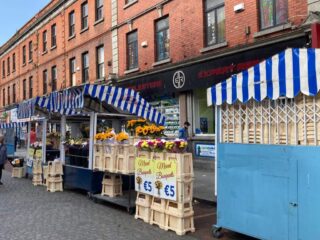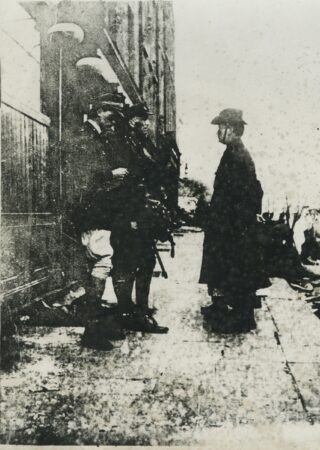Fógra
WARNING: It should be noted that these sites are unguided and a level of care and caution should be maintained during all stages of your visit. The Office Of Public Works (OPW) will not be held responsible for any damages, injuries, or losses that occur
Moore Street (no. 14 – 17)
It is impossible to think of Moore Street and not think of the 1916 Easter Rising. The rebellion and these 18th century houses are synonymous with each other in recent history.
These terraced, three storey houses were built around 1760 and had their front facades restored around 1900. Currently, conservation and repair works are taking place in order to turn these 4 houses into a commemorative centre. During these current works, excavations took place and approximately 4000 artefacts were discovered under the floorboards. Items such as match-boxes and sewing paraphernalia were found, indicating a small factory or industry of some sort. Other items include jewellery and a pamphlet with images of Robert Emmet and Edward Fitzgerald.
After the GPO headquarters had to be evacuated during the rebellion, they escaped to the houses on Moore Street, which became their new impromptu headquarters.
It is recognised that it was at no. 16 Moore Street that the decision to surrender was agreed. Pearse wrote: ‘In order to prevent further slaughter of the civil population and in the hope of saving the lives of our followers, the members of the Provisional Government present at headquarters have decided on an unconditional surrender.’
It is said that this decision came about because Pearse saw a family being shot at by British soldiers as he looked out the window of no. 16 and watched as the father was killed. The O’Rahilly was also shot as he tried to escape from the burning GPO, and slowly bled to death over a day in a doorway on Moore Lane.
The famous photograph of Pádraig Pearse and Elizabeth O’Farrell issuing the surrender notice to General Lowe and his son was taken at the top of Moore Street.
Visit Historic Environment Viewer for more information on 14 – 17 Moore Street
Protect our Past - Click here to read about the importance of protecting our country’s unique heritage sites
This national monument is protected in accordance with the National Monuments Acts 1930 to 2014
Gailearaí
Suíomhanna cóngarach
Caisleán Bhaile Átha Cliath
Croílár chumhacht stairiúil na hÉireann
Timpeall 0.9 km ón
Eaglais agus Ionad Cuairteoirí San Audeon
Séipéal meánaoiseach i gcroílár shaol na cathrach
Timpeall 1.0 km ón
Faiche Stiabhna
Seoid chathartha ó ré Victoria sa chearnóg gairdín is mó i mBaile Átha Claith
Timpeall 1.2 km ón



